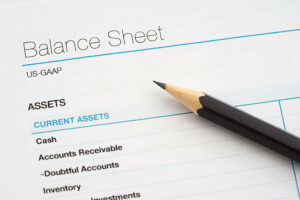
Suppose a company issues 1000 shares and 200 shares are kept in the company’s treasury, determine the company’s shares outstanding. Their market cap might be large simply because the share price is high. Companies with big news that affects their number of shares outstanding, such as stock splits, announce the events in press releases that are reported by the business media. Now, imagine you are one of the shareholders in XYZ that did not sell their shares as part of the buyback program. From your perspective, you now own a larger percentage of the company, since the total number of shares outstanding has declined.

Restricted shares are the shares outstanding reserved for employees and insiders. This includes preferred, common, and restricted shares but excludes shares owned by the company. A recent example of a reverse stock split is General Electric’s (GE) 1-for-8 reverse stock split shares outstanding formula during the summer of 2021. The float is the portion of outstanding shares that’s most relevant for smaller investors. The shares companies issue are known as authorized shares, which are the maximum number of shares they are lawfully permitted to make available to investors.
How Do Stock Buybacks Influence Shares Outstanding?
The investor would multiply the number of shares acquired at each price by that price and then add those values together. Lastly, divide the total value by the total number of shares purchased to arrive at the weighted average share price. If there exists a difference between the number of shares issued and outstanding shares, the difference is treasury stock. In other words, the company issued some shares to investors and then bought back some of the shares.
Alternatively, the total number of shares outstanding can be easily calculated as a company’s market capitalization divided by the current share price. Shares outstanding are the stock that is held by a company’s shareholders on the open market. Along with individual shareholders, this includes restricted shares that are held by a company’s officers and institutional investors. A company’s outstanding shares decrease when there is a reverse stock split. A company generally embarks on a reverse split or share consolidation to bring its share price into the minimum range necessary to satisfy exchange listing requirements.
Outstanding shares vs float
In contrast, a stock with a significantly lower number of outstanding shares would be more susceptible to price manipulation since it would take a significantly smaller number of shares to alter the price of the stock. Please don’t confuse shares outstanding with authorized stock and issued stock as they are completely different, https://www.bookstime.com/ and shares outstanding is a subset of both authorized stock and issued stock. Other companies might have a lot of outstanding shares but a low price. But the number of shares outstanding can’t exceed the number of issued shares. And the number of issued shares can’t exceed the authorized total number of shares.
- In the case of Apple, this shows that the company had 15,552,752,000 shares of common stock “issued and outstanding” as of October 20th, 2023.
- It includes shares held by the general public and restricted shares that are owned by company officers and insiders.
- The first of these, unrestricted shares, is also known as “the float.” These are the shares that can be actively traded on the open market.
- The number of outstanding shares increases when the firm decides to issue additional shares.
- A share repurchase generates a higher income per share, making each share more valuable.
- Of course, merely increasing the number of outstanding shares is no guarantee of success; the company has to deliver consistent earnings growth as well.
A company may announce a stock split to increase the affordability of its shares and grow the number of investors. For instance, a 2-for-1 stock split reduces the price of the stock by 50%, but also increases the number of shares outstanding by 2x. Because investors frequently purchase shares of a company at various times and in various amounts as they build their position in a stock, it can be a challenge to keep track of the cost basis of those shares. One method is for the investor to calculate a weighted average of the share price paid for the shares.
Weighted Average Shares Outstanding
During a share buyback, the company buys its own shares from the shares outstanding and turns them into treasury shares. The company can’t sell them into the open market unless it issues new shares with a dilution or stock split. StocksToTrade makes it easy to view both a company’s stock float and shares outstanding.
- If the company doesn’t have treasury shares, the number of issued shares should be the same as the number of shares outstanding.
- This represents an 11% increase in EPS, solely due to the reduction in the number of shares outstanding.
- The outstanding shares of a company can fluctuate for a number of reasons.
- And if there’s a difference between the number of shares issued and the number of shares outstanding — the difference is treasury stock.
- Next, 336,620,000 shares were held in the company’s treasury at that time, so subtracting this from the number of issued shares means that Johnson & Johnson had 2,783,223,000 outstanding shares at the end of 2014.
- Authorized shares are the maximum number of shares a company can issue according to its articles of incorporation.
Another factor that causes the outstanding stocks of a company to fluctuate is the stock split. On the other hand, it will reduce if the company undertakes a reverse stock split. Usually, companies undertake stock splits in order to bring a company’s share price within the buying range of retail investors. On the other hand, a company generally embarks on a reverse split or share consolidation if it wants to bring its share price into the minimum range necessary to satisfy exchange listing requirements. The weighted average of outstanding shares is a calculation that incorporates any changes in the number of a company’s outstanding shares over a reporting period.
How Stock Buybacks and Issuances Impact Shares Outstanding
Outstanding shares — or shares outstanding — aren’t as extraordinary as their name implies. Generally speaking, stocks with smaller floats will experience more volatility than those with larger floats. Want to put your savings into action and kick-start your investment journey 💸 But don’t have time to do research? Invest now with Navi Nifty 50 Index Fund, sit back, and earn from the top 50 companies. It is advisable to carefully go through the company’s financials before putting your money in!

An example of this is when employees of the company convert their employee stock options (ESO) into shares. Basic EPS uses outstanding shares, which are actually held by the public and company insiders. These shares are non-dilutive because they do not include any options or securities that can be converted. To achieve a proper and fair view of the changes in the number of shares and for the calculation of EPS, the method of weighted average shares outstanding is used. Basic shares refer to the number of outstanding shares that are currently outstanding while diluted shares put into consideration things such as warrants, capital notes, and convertible stock. In essence, the fully diluted number of outstanding shares tells us the number of shares outstanding there could potentially be.
